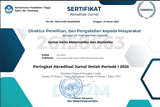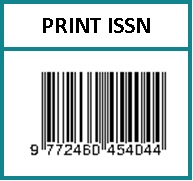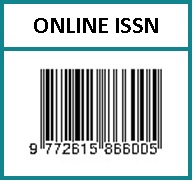Prediksi Prevalensi Diabetes Tipe 2 menggunakan Artificial Neural Network
Abstract
Prediksi prevalensi Diabetes Mellitus Tipe 2 merupakan salah satu upaya pengelolaan sebaran penyakit. Penelitian ini bertujuan memprediksi angka prevalensi DM tipe 2 menggunakan metode Artificial Neural Network (ANN). Data yang digunakan dalam penelitian ini menggunakan data sekunder yang berasal dari data rekam medis elektronik pasien DM tipe 2 pada periode Januari 2019 sampai Desember 2022. Data dibagi menjadi data training dan data testing. Data training adalah angka prevalensi DM tipe 2 mulai januari 2019 sampai juni 2022. Data testing terdiri dari angka prevalensi DM tipe 2 mulai Juni 2022 sampai desember 2022. Grafik deret waktu memberikan informasi trend DM tipe mengalami kenaikan pada tahun 2022. Pemilihan model ANN yang terbaik dilakukan dengan melakukan prediksi dengan data testing menggunakan jumlah neuron yang berbeda yaitu 2 sampai 10 neuron. ANN dengan 2 neuron pada hidden layer merupakan metode terbaik dengan nilai RMSE sebesar 0,419. Hasil prediksi angka prevalensi DM tipe 2 periode januari sampai juni 2023 memiliki pola yang cenderung stasioner.
Kata Kunci: Prevalensi, Diabetes Mellitus tipe 2, Artificial Neural Network.
Full Text:
PDF (Bahasa Indonesia)References
Daftar Pustaka
Dinkes Jatim, “Profil Kesehatan Dinas Kesehatan Provinsi Jawa Timur 2021,” Dinas Kesehat. Provinsi Jawa Timur, pp. 1–149, 2021.
E. Yang et al., “A simulation-based study on the comparison of statistical and time series forecasting methods for early detection of infectious disease outbreaks,” Int. J. Environ. Res. Public Health, vol. 15, no. 5, 2018, doi: 10.3390/ijerph15050966.
C. S. Lutz et al., “Applying infectious disease forecasting to public health: A path forward using influenza forecasting examples,” BMC Public Health, vol. 19, no. 1, pp. 1–12, 2019, doi: 10.1186/s12889-019-7966-8.
M. Y. Anwar, J. A. Lewnard, S. Parikh, and V. E. Pitzer, “Time series analysis of malaria in Afghanistan: using ARIMA models to predict future trends in incidence,” Malar. J., vol. 15, no. 1, pp. 1–10, 2016, doi: 10.1186/s12936-016-1602-1.
B. Xu, J. Li, and M. Wang, “Epidemiological and time series analysis on the incidence and death of AIDS and HIV in China,” BMC Public Health, vol. 20, no. 1, pp. 1–10, 2020, doi: 10.1186/s12889-020-09977-8.
N. Shahid, T. Rappon, and W. Berta, “Applications of artificial neural networks in health care organizational decision-making: A scoping review,” PLoS One, vol. 14, no. 2, pp. 1–22, 2019, doi: 10.1371/journal.pone.0212356.
K. W. Wang, C. Deng, J. P. Li, Y. Y. Zhang, X. Y. Li, and M. C. Wu, “Hybrid methodology for tuberculosis incidence time-series forecasting based on ARIMA and a NAR neural network,” Epidemiol. Infect., vol. 145, no. 6, pp. 1118–1129, 2017, doi: 10.1017/S0950268816003216.
L. Rabelo, D. A. Morais, and G. Soares, “Forecasting daily Covid-19 cases in the world with a hybrid ARIMA and neural network model,” vol. 126, no. January, 2020.
Y. Zheng, X. Zhang, X. Wang, K. Wang, and Y. Cui, “Predictive study of tuberculosis incidence by time series method and Elman neural network in Kashgar, China,” BMJ Open, vol. 11, no. 1, pp. 1–8, 2021, doi: 10.1136/bmjopen-2020-041040.
K. Tang, R. Luo, and S. Zhang, “An Artificial Neural Network Algorithm for the Evaluation of Postoperative Rehabilitation of Patients,” J. Healthc. Eng., vol. 2021, 2021, doi: 10.1155/2021/3959844.
H. R. Lou, X. Wang, Y. Gao, and Q. Zeng, “Comparison of ARIMA model, DNN model and LSTM model in predicting disease burden of occupational pneumoconiosis in Tianjin, China,” BMC Public Health, vol. 22, no. 1, pp. 1–15, 2022, doi: 10.1186/s12889-022-14642-3.
Jerhi Wahyu Fernanda and F. N. Sidjabat, “Prediksi Incidence Dengue Hemorrhagic Fever (Dhf) Menggunakan Jaringan Saraf Tiruan (Artifial Neural Network),” J. Manaj. Inf. Kesehat. Indones., vol. 6, no. 2, p. 142, 2018, doi: 10.33560/.v6i2.199.
J. Han, J. Pei, and H. Tong, Data Mining Concepts and Techniques Fourth Edition. 2023.
I. A. T. Wulandari, S. Herawati, and I. N. Wande, “Program Studi Sarjana Kedokteran dan Profesi Dokter, Fakultas Kedokteran Universitas Udayana 2 Departemen Patologi Klinik Fakultas Kedokteran Universitas Udayana Koresponding author: Ida Ayu Trisna Wulandari,” J. Med. Udayana, vol. 9, no. 1, pp. 71–75, 2020.
S. Gunawan and R. Rahmawati, “Hubungan Usia, Jenis Kelamin dan Hipertensi dengan Kejadian Diabetes Mellitus Tipe 2 di Puskesmas Tugu Kecamatan Cimanggis Kota Depok Tahun 2019,” ARKESMAS (Arsip Kesehat. Masyarakat), vol. 6, no. 1, pp. 15–22, 2021, doi: 10.22236/arkesmas.v6i1.5829.
K. Adri, A. Arsin, and R. M. Thaha, “Faktor Risiko Kasus Diabetes Mellitus Tipe 2 Dengan Ulkus Diabetik Di Rsud Kabupaten Sidrap,” J. Kesehat. Masy. Marit., vol. 3, no. 1, pp. 101–108, 2020, doi: 10.30597/jkmm.v3i1.10298.
U. A. Yakubu and M. P. A. Saputra, “Time Series Model Analysis Using Autocorrelation Function (ACF) and Partial Autocorrelation Function (PACF) for E-wallet Transactions during a Pandemic,” Int. J. Glob. Oper. Res., vol. 3, no. 3, pp. 80–85, 2022, doi: 10.47194/ijgor.v3i3.168.
M. Mayawi, N. Nurhayati, T. Talib, A. W. Bustan, and N. S. Laamena, “Ordinal Logistic Regression Analysis of Factors that Affecting the Blood Sugar Levels Diabetes Mellitus Patients,” Pattimura Int. J. Math., vol. 2, no. 1, pp. 33–42, 2023, doi: 10.30598/pijmathvol2iss1pp33-42.
A. Kautzky-Willer, M. Leutner, and J. Harreiter, “Sex differences in type 2 diabetes,” Diabetologia, vol. 66, no. 6, pp. 986–1002, 2023, doi: 10.1007/s00125-023-05891-x.
C. X. Ma, X. N. Ma, C. H. Guan, Y. D. Li, D. Mauricio, and S. B. Fu, “Cardiovascular disease in type 2 diabetes mellitus: progress toward personalized management,” Cardiovasc. Diabetol., vol. 21, no. 1, pp. 1–15, 2022, doi: 10.1186/s12933-022-01516-6.
S. De Rosa, B. Arcidiacono, E. Chiefari, A. Brunetti, C. Indolfi, and D. P. Foti, “Type 2 diabetes mellitus and cardiovascular disease: Genetic and epigenetic links,” Front. Endocrinol. (Lausanne)., vol. 9, no. JAN, pp. 1–13, 2018, doi: 10.3389/fendo.2018.00002.
D. Sagastume, I. Siero, E. Mertens, J. Cottam, C. Colizzi, and J. L. Peñalvo, “The effectiveness of lifestyle interventions on type 2 diabetes and gestational diabetes incidence and cardiometabolic outcomes: A systematic review and meta-analysis of evidence from low- and middle-income countries,” eClinicalMedicine, vol. 53, pp. 1–14, 2022, doi: 10.1016/j.eclinm.2022.101650.
DOI: http://dx.doi.org/10.24014/jsms.v10i2.26622
Refbacks
- There are currently no refbacks.
Jurnal JSMS
p-ISSN : 2460-4542 (print)
e-ISSN : 2615-8663 (online)
Alamat : Program Studi Matematika
Fakultas Sains dan Teknologi, UIN Suska Riau
Jl. H.R Soebrantas, No. 155, Tampan, Pekanbaru.
Website : http://ejournal.uin-suska.ac.id/index.php/JSMS
e-mail : jsmsfst@uin-suska.ac.id

This work is licensed under a Creative Commons Attribution-NonCommercial-NoDerivatives 4.0 International License.
















